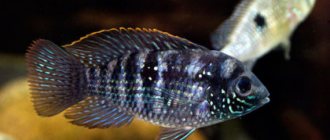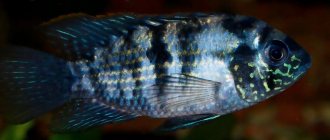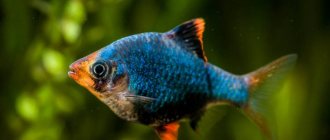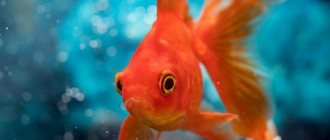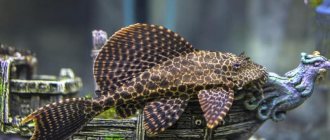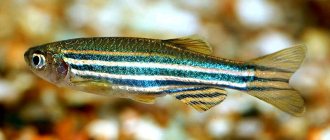Turquoise acara (lat. Andinoacara rivulatus, synonym Aequidens rivulatus) is a brightly colored cichlid with a body covered with bright blue scales. But the richness of her coloring does not end there, nor does her interesting behavior.
This species is often confused with another similar fish, the blue-spotted acara. At one time they were indeed considered one species, but have now been divided into two different ones. Although they are similar, there are also significant differences.
The turquoise one is larger and in nature can reach a size of 25-30 cm, while the bluish-spotted one reaches 20 cm.
A sexually mature male turquoise will develop a noticeable fatty bump on its head, while a male bluespot will have a less pronounced fat bump.
Well, in addition, turquoise is much more aggressive; in English-speaking countries it is even called Green Terror - green horror.
At the same time, it is a fairly unpretentious fish that it simply takes care of. However, it should only be recommended to experienced aquarists, as it is demanding on water parameters and needs high-quality feeding.
Plus, as is often the case with large cichlids, the turquoise is aggressive and large, and needs a spacious aquarium.
While they are young, they grow successfully with other cichlids, but as they grow older they become more and more aggressive and it is better to keep them with large and equally aggressive neighbors.
Description and characteristics
The Turquoise Acara is a popular cichlid kept in home aquariums. This is due to the fact that it is relatively unpretentious compared to other species, but the fish is very beautiful and is easy to get on sale.
Akara turquoise also known as Green Terror
Why is it called that?
The official name of this original fish is Andinoacara rivulatus. The fish belongs to the cichlid genus. Turquoise got its name due to the bright shiny scales that cover its entire body. Moreover, in the light, the acara scales shimmer with the most specific shades, which gives it incredible beauty and radiance. Aquarists love to place such fish in their aquarium, as they can be watched for hours.
Interesting fact!
The colloquial name for this fish is “Green Terrorist”. This is due to the bright shade of the fish and its aggressive nature.
Appearance and photo
Perhaps the bright and catchy appearance of this fish is the main thing that attracts aquarists to it. The entire surface of the acara in the photo is covered with turquoise scales, which have different shades.
The body itself has a silver-gray tint, with dark blue dots scattered throughout it, which change their color depending on the light. Because of this, the scales of the fish look as if they are glowing from within.
The size of the fish is large - it reaches from 20 to 30 cm. On the front of the fish there are wavy turquoise streaks. The back, rear and lower fins are shiny blue with white or yellow edging. A distinctive feature of males is a fatty growth on the forehead.
Akara in nature
The historical homeland of cancer is considered to be reservoirs located in the northwestern part of Peru and the Rio Esmeraldas River basin. They are also found in South America, Central Colombia, Brazil and some other countries, preferring bodies of water without strong currents with rich vegetation and multiple shelters.
Cancers have been kept in aquariums since the seventies of the last century, and today they are one of the most sought-after cichlids among fish lovers.
Maintenance and care
As for care and maintenance, the turquoise acara cannot be called one of the most capricious aquarium fish, however, it still has its peculiarities.
Requirements for an aquarium
First of all, you need to choose the right aquarium. It should be spacious. The fact is that the turquoise acara is a large fish. In the natural environment, its size reaches up to 35 cm and even more, but in an aquarium, the fish grows no more than 20 cm in length.
Important!
The smaller the aquarium, the less opportunities the fish have. On average, it is desirable that there be at least 300 liters of water per fish.
If more than one individual lives in one aquarium, then its volume should be twice as large; you can choose jebo aquariums. A too cramped aquarium not only limits the growth of the fish, but also shortens the life cycle of the fish and changes its color.
Water requirement
The water in the aquarium is no less important. In its natural environment, the turquoise acara prefers to settle in quiet bodies of fresh water without a noticeable current. In order for the fish to develop and feel comfortable in the aquarium, it is necessary to bring the aquarium conditions as close as possible to natural ones.
The water in the aquarium should be crystal clear. To do this, you will have to install a reliable filter with aeration, and also regularly change the water in the aquarium. This should be done at least once a week at least by 30%. When replacing, fresh water is added extremely slowly and carefully; adding water too quickly can even provoke the appearance of diseases in turquoise cancers.
Shelters
It is best to place clean pebbles on the bottom of the aquarium. The turquoise acara does not need green space like some other fish, but if the owner does want to plant algae, it is best to use pots or carefully secure the plants with stones. The fact is that the fish digs up plants from the ground or stones. In natural conditions, cichlids like to hide in piles of stones, special houses or driftwood. Therefore, it is advisable to recreate a similar environment in the aquarium.
Representatives of this breed prefer a quiet environment
Mr. Tail Recommends: Aquarium Basics
Turquoise acara is a rather aggressive species of fish, especially females, which is why the condition for their comfortable keeping is the presence of sufficient personal space - aquariums with a volume of 100 liters per individual.
Landscaping of the tank must be done with non-living or unpretentious plants with strong rhizomes: echinodorus, Java fern, Java moss. Substrate: round stones of medium fraction (up to 10 mm in diameter).
For decoration they use driftwood, large flat stones, caves and other places where you can hide. They should be well secured to the bottom, since Turquoise acaras tend to rummage through the entire contents of the aquarium during reproduction.
Habitat indicators:
- temperature +23…+25 °C;
- acidity 6-8 pH, hardness 5-13 dGH;
- high-quality aeration, filtration;
- weekly water changes - at least 1/3 of the available volume;
- The lighting is average, daylight hours are up to 9 hours.
What to feed
One of the most important questions is: what to feed the turquoise acara in the aquarium, since in nature this fish has the habits of a predator. Fish eat all kinds of insects, tiny fish, invertebrates, larvae, etc. But in general, this fish is not picky; it easily eats both ready-made live food and frozen and even fixed food. Some aquarists buy small, lean fish and shrimp specifically for their fish.
The main thing is that adults get enough protein food, because they are predators. As for dry food, you need to make sure that there is not too much of it, otherwise the water in the aquarium will quickly become clogged.
Feeding
It is primarily a predator, it eats all types of food, but can be capricious. In the aquarium, she eats both live and frozen tubifex, bloodworms, brine shrimp, gammarus, crickets, worms, fish fillets, shrimp and mussel meat and other high-calorie foods.
Modern food for large cichlids can provide healthy nutrition, and in addition the menu can be diversified with live food.
You can also add vitamins and plant foods, such as spirulina, to the food.
You need to feed her 1-2 times a day, trying to give as much food as she can eat at once.
Compatibility with other fish
One of the problems associated with keeping turquoise acara in an aquarium is its difficult compatibility with other fish. This applies not only to a specific species, but also to other fish from the cichlid genus. Therefore, neighbors for Akara are selected extremely carefully.
If you add tiny fish to an aquarium, the acara will accidentally eat them. If you choose similar large fish as neighbors, then there is a high probability that conflict and competition for territory will arise between them. However, most cichlids coexist amicably in the same aquarium with their pets. The main thing is that the volume of the aquarium allows this.
The fish very often exhibits increased aggression towards its neighbors in the aquarium.
Compatible
There are a number of fish with which the turquoise acara coexists quite calmly. These include:
- Cichlazoma severum;
- Red parrot fish;
- Astronotus;
- Synodontis;
- Petrigoplicht;
All these fish coexist more or less calmly in the same aquarium with the turquoise acara. But it is worth considering that cyclazoma is very jealous of its territory, and in this case it is best to partition the space with the help of snags or decorative elements. The aquarium fish Astronotus can be added to the acara only if the volume of the aquarium allows. Both types of fish need a lot of free space. But Pterygoplich gets along well not only with Acaras, but also with any other cichlids.
Not compatible
Turquoise acara, like other types of cichlids, should not be placed in the same aquarium with small fish, including:
- Guppy;
- Angelfish;
- Barbs;
- Goldfish;
- Neons;
- Ampoules;
- Corridors.
The reasons for this are simple: a large acara can eat its tiny neighbors in the aquarium, since in their natural environment cichlids feed on similar types of fish.
Fact!
Small fish are not the optimal environment not only for turquoise cichlids, but also for other species of cichlids.
Relatively compatible species
Relatively compatible species include African cichlids. These fish are placed together in the same aquarium, but there are a number of differences. First of all, it's water. Under natural conditions, the turquoise acara lives in soft, quiet water, but African cichlids require mineralized alkaline water.
On average, African cichlids are slightly smaller in size than cichlids. However, in aquarium conditions, the size of both will be approximately 15 cm in length. But in general, adult individuals of these fish species do not conflict with each other and get along in the same aquarium.
It is dangerous to add small species of cichlids to acara
Range and Habitat
South America: from the Pacific part from the Esmeraldas River in Ecuador to the Tumbes River in Peru.
Type locality: Andes of western Ecuador.
Widely distributed in western Ecuador, from the Andean foothills to the Pacific coast and from the Rio Chone and Portoviejo watercourses (rivers, streams, canals) in the north to the river systems draining the Golfo de Guayaquil, including also the Rio Zarumilla and Rio Tumbes in the extreme northwest of Peru.
The Esmeraldas River is a 210-kilometer-long river in northwestern Ecuador that flows into the Pacific Ocean near the city of Esmeraldas.
Nieuwenhuizen (cited by Stawikowski & Werner 1998) observed this species in the thermal waters of Budapest and around Lake Balaton (Hungary).
Found in a wide range of riverine habitats, from clear, fast-flowing mountain streams to residual pools, algae-filled ditches and wide, muddy lower reaches of large rivers. They have been observed over a bottom of gravel, sand, silt or sunken leaves, among trees or aquatic plants. They were found in the shallow coastal zone, as well as in the stronger current and deeper waters in the middle of the river. Large specimens over 20 cm were observed exclusively in deep water. Water parameters were fairly uniform (temperature around 25°C, 1-2°C less in higher regions; pH around 7; 3°KH; no more than 1°dGH).
Reproduction and breeding
Unlike many other aquarium fish species, breeding the Turquoise Acara is not difficult. Moreover, these fish often live and move in pairs. The most difficult thing is to find a mate for your fish.
Acara becomes sexually mature at about 8 months; until this moment, the fish often gather in schools, but after the onset of maturity they stay either in twos or alone. They choose their mate on their own, so finding a fish of the opposite sex will not be enough.
Spawning does not require any special conditions; this type of fish has a highly developed parental instinct, so breeding fish is possible even in an aquarium, if they are close to the natural conditions of existence of the acara.
Note!
The differences between males and females are striking: males are much larger, their color is brighter and more saturated, the color of females is darker. There is another significant difference: the fatty growth on the head of the male.
Requirements for the spawning tank
When fish are ready to spawn, some aquarists stimulate this process by increasing the water temperature. The main thing is that there is a stone or driftwood in the aquarium so that the female finds a suitable secluded place for spawning. Sometimes fish can dig a hole in the sand or soil.
Breeding procedure
The most difficult thing in the procedure of home breeding of turquoise acara is finding a suitable pair. After this, the male and female just need to be placed in the same aquarium, and spawning will happen by itself over some time, if, of course, the conditions in the aquarium meet the required ones. You won't have to put in any extra effort.
Both the eggs and the fry are cared for by both parents
How to distinguish Andinoacara rivulatus from other species
This fish is similar to its close relative Andinoacara stalsbergi. This species was brought to the USSR in the 70s and received the name emerald acara, but the name did not stick.
Turquoise Acara (A. Rivulatus) grows slightly larger. The best way to tell the difference between the two varieties is to compare the color of the scales and fin trim. In A. Rivulatus, the scales have a light blue-green edge with a dark center, and the dorsal and caudal fins have a broad orange or white edge. The scales of A. stalsbergi are the opposite, with a dark blue to green center and dark edging, fins with a thin silver-white edge.
This species is also confused with its similar sister Blue Acara Aequidens pulcher. They are similar in some aspects, but there are key differences.
On the left is a bluish-spotted acara, on the right is a turquoise one.
The color of Blue Acara is primarily a steely blue-gray with less of a greenish sheen. Turquoise acara is larger, reaching a length of 25-31 cm, and Blue Acara grows to approximately 21 cm. Mature Andinoacara rivulatus develops a pronounced growth on the head, and Blue Acara has a flat forehead.
Diseases and prevention
Although this fish is quite unpretentious and resistant to a variety of unfavorable conditions, it still happens that the fish gets sick. If desired, the disease can be cured, the main thing is to notice it in a timely manner and take action. Below we will present the most common diseases in turquoise cancer.
Spironucleosis
This disease is associated with the fish's digestive system. It can be recognized by the secretion of mucus, as well as by poor digestion of food. At the same time, the cichlid begins to actively lose weight in the upper part, and the fish’s belly, on the contrary, swells. If ulcers appear on the head, then this is a sure sign of a late stage of development of spironucleosis.
To treat this disease, it is necessary to take baths with the addition of metronidazole every day. For the treatment to be effective, baths must be done for at least 12 days. After some time, it is advisable to repeat the course. You need to move the fish very carefully so as not to injure it.
Saprolegniosis
Spironucleosis is a fungal disease that manifests itself in the form of fairly large white spots throughout the body of the fish. With this disease, the rays of the tail and fins can stick together, and the scales peel off and bristle in all directions. Moreover, the fish’s body may even begin to bleed in particularly advanced cases of the disease. Treated with hour-long baths. Copper sulfate, manganese or streptocide must be added to the water. The fish is immersed in the resulting solution for about an hour. The procedure must be carried out periodically.
Attention!
It is important to be extremely careful, as any incorrect actions can only aggravate the problem. If experience and skills are not enough, it is best to consult an experienced aquarist.
Ascites
This disease does not rarely occur in turquoise cancer. It is characterized primarily by bulging eyes, significant bloating of the abdomen, and problems with the scales. This disease can be quite dangerous. Moreover, the fish can be cured only in the later stages of the disease.
If the owner notices mucous discharge in the fish’s stool, this is a sign that the disease is at a late stage. As a treatment, antibiotics are mixed into dry food for cichlids. Medicines must be prescribed by a doctor. Choosing antibiotics on your own can harm your fish.
If a sick individual is discovered, it is recommended to immediately isolate it
Cancer Care
Caring for this type of aquarium fish is not difficult. Acara forms pairs on its own, but when deciding to engage in breeding, several young animals are initially acquired. After a productive pair is formed, the remaining individuals are placed in a separate aquarium . If necessary, spawning can be artificially stimulated by increasing the temperature and replacing a large amount of water.
Nutrition and diet
A bright and beautiful aquarium fish requires not only proper care, but also a complete diet. Chopped shrimp, mussels and squid, as well as fillets of almost any sea fish, including hake, cod and pink salmon, are very suitable for feeding acara. Young individuals can be fed with homemade minced fish with the addition of chopped lettuce or spirulina.
Ready-made dry food produced by such well-known manufacturers as Tetra, Sera and Nikari have also proven themselves very well. It is advisable to give preference to fairly large granulated food such as Sera Granuar or dry sticks Sera Ciсhlids Sticks, Tetra сichlid Sticks. Food is given to the fish a couple of times a day. It is recommended that adult fish have one fasting day every week .
Price
As a rule, the cost of a fish directly depends on its size, age and other individual characteristics. On average, the cost of a turquoise akara starts from 200 rubles. An adult will cost much more - its cost can even reach several thousand rubles.
Also, those who are thinking about buying a turquoise acara should take into account that they will additionally need to purchase equipment, in particular, a spacious aquarium with a filter and filling for it: natural sand or small pebbles, decorative elements and much more.
Difficulty in content
Although this is a very beautiful fish that attracts the attention of aquarists, it cannot be recommended for beginners. Turquoise acara is a large and aggressive fish that requires a lot of free space to keep. A pair of akaras can literally terrorize their neighbors and need to be kept with large and strong fish. In addition, they are very sensitive to water parameters and sudden changes. Due to these circumstances, turquoise cichlids can only be recommended to aquarists who already have experience in keeping large cichlids. True, even a beginner can successfully keep them only if he can create suitable conditions and select large neighbors.
Interesting Facts
There are a few interesting facts you need to know about turquoise cancers:
- During spawning, males can show unexpected aggression. This is due to the natural desire to protect their offspring.
- You can determine the approximate age of a male by the growth on the forehead of the fish - the larger it is, the older the animal.
- Turquoise acara has an accelerated metabolism, due to this, the fish constantly pollute the water in the aquarium, although they prefer clean, fresh water. You can't do without a reliable filter.
Sex differences
There are few differences between males and females and sex determination before puberty is difficult.
The male has a red edge on his caudal fin, is much larger, and develops a fatty bump on his forehead that the female does not have.
The peculiarity of the female is that she is usually more aggressive than the male, especially during spawning. Usually with cichlids the opposite is true.
Reviews
Keeping turquoise acara in a home aquarium requires considerable attention and effort. The main thing you need to take into account is that it is not advisable to place this fish in cramped aquariums, and it does not successfully coexist with all representatives of aquarium fish.
Would you like to purchase this fish for your own aquarium? Share in the comments!
Neighbors for the turquoise terrorist
Turquoise Acara's territorial and intraspecific aggression requires keeping it in pairs.
The compatibility table will help you better navigate in choosing neighbors for your turquoise acara.
Compatibility with other aquarium fish depends on the nature and proportionality. In large artificial reservoirs, fish coexist with the following species:
- astronotuses;
- red parrots;
- small cichlazomas;
- severums;
- flowernhorny;
- plecostomus;
- chain catfish.
The proximity of turquoise cancers to overly aggressive Managuan and red-necked cichlids is fraught with tragic consequences. For obvious reasons, cichlids are incompatible with small and medium-sized fish.
Relying on several sources, you will populate the aquarium more accurately and with better quality.
Description of the aquarium fish
The fish has a tall and large body. The color can vary from silver to green with a beautiful turquoise tint. There are wavy turquoise lines on the muzzle and gill covers, and a dark spot of arbitrary shape in the center of the body. There is a wide edge on the caudal and dorsal fin.
In nature, acara grows up to 25-30 cm, in captivity - up to 15-20 cm. The lifespan of the fish is about 10 years.
Where to buy and price?
You can purchase healthy aqua in the capital and other large cities from modern companies specializing in aquarium breeding. In addition, many private breeders of large predatory aquarium fish are engaged in the sale of this species.
The cost varies depending on the age and gender of the fish:
- individuals with a body length of up to 80 mm or size “M” - from 280 rubles;
- individuals with a body length of up to 120 mm or size “L” - from 900 rubles;
- individuals with a body length of up to 160 mm or size “XL” - from 3,200 rubles.
The cost of adults and juveniles sold by private breeders can be an order of magnitude lower.
Natural enemies of turquoise cancers
Photo: Turquoise acara fish
Akaras are not of commercial interest for economic activity. The ease of breeding in captivity has caused a loss of interest in these fish from suppliers of aquarium fish to retail chains in America, Europe and Asia, and the low nutritional value does not arouse interest from companies involved in catching table fish species.
Thus, the circle of enemies of cancer is outlined by predators, for which these fish are natural food. Such enemies primarily include juvenile caimans, whose diet in the first periods of life is based on small fish and large insects. Animals such as the predatory Matamata turtle also successfully hunt the carp. Great damage to acar populations is also caused by herons of various species that hunt fish in shallow waters. Juveniles of such predatory fish as arapaima do not disdain akars.
Perhaps the main enemy of the cancer was such skilled hunters as the Brazilian otters. However, a significant reduction in the population of the latter due to human intervention in the nature of the Amazon has removed these predators from the list of the main enemies of cancer. At present, no animal has been identified that preys only primarily on carnivores. Therefore, it is impossible to talk about specific enemies of these fish.
Kinds
For a long time, all cancers were classified in the genus Aequidens, but due to too many differences in species, after the 1986 revision they were divided into 5 genera: bujurquina, cleytracara, guianacara, crobia, letacara.
As for the species, there are more than thirty of them: Peruvian, spotted, turquoise, red-breasted, blue, silver, black-striped and others, there is no point in listing them all. Let's look at a few of the most popular ones:
- The bluish-spotted acara naturally lives in water bodies of Panama and Colombia, preferring those where the current is slow or absent. It appeared in Russia in 1910.
Its body size in captivity does not exceed 6-8 cm. The fish is colored in grayish-brown tones. There are many spots: oblong dark ones across the body, black in the tail area, shiny bluish-green throughout the body. The fin on the back is dark blue with a red border. This species is peaceful and can be kept with other fish. - Acara Meri is common in South America and lives in the reservoirs of its northern part. In an aquarium it does not grow more than 12 cm in length. The body color is olive-silver with a dark back and a light belly. All fins are red, except for the dorsal one (it is sea green). The iris of the eyes is golden yellow. There is a dark stripe running from the eye to the tail. The entire body is decorated with shiny blue spots and strokes.
- Acara Paraguayan lives in the very center of South America. This yellowish-brown fish can grow up to 12 cm. The entire body, including the fins, is covered with shiny green spots, and there are dark stripes on the sides. In small aquariums, Paraguayan acara become aggressive even towards their fellows.
